Recommendation
Recommendation is the task of providing personalized suggestions to users based on their preferences and behavior.
Papers and Code
DMGIN: How Multimodal LLMs Enhance Large Recommendation Models for Lifelong User Post-click Behaviors
Aug 29, 2025Modeling user interest based on lifelong user behavior sequences is crucial for enhancing Click-Through Rate (CTR) prediction. However, long post-click behavior sequences themselves pose severe performance issues: the sheer volume of data leads to high computational costs and inefficiencies in model training and inference. Traditional methods address this by introducing two-stage approaches, but this compromises model effectiveness due to incomplete utilization of the full sequence context. More importantly, integrating multimodal embeddings into existing large recommendation models (LRM) presents significant challenges: These embeddings often exacerbate computational burdens and mismatch with LRM architectures. To address these issues and enhance the model's efficiency and accuracy, we introduce Deep Multimodal Group Interest Network (DMGIN). Given the observation that user post-click behavior sequences contain a large number of repeated items with varying behaviors and timestamps, DMGIN employs Multimodal LLMs(MLLM) for grouping to reorganize complete lifelong post-click behavior sequences more effectively, with almost no additional computational overhead, as opposed to directly introducing multimodal embeddings. To mitigate the potential information loss from grouping, we have implemented two key strategies. First, we analyze behaviors within each group using both interest statistics and intra-group transformers to capture group traits. Second, apply inter-group transformers to temporally ordered groups to capture the evolution of user group interests. Our extensive experiments on both industrial and public datasets confirm the effectiveness and efficiency of DMGIN. The A/B test in our LBS advertising system shows that DMGIN improves CTR by 4.7% and Revenue per Mile by 2.3%.
Benchmarking GPT-5 in Radiation Oncology: Measurable Gains, but Persistent Need for Expert Oversight
Aug 29, 2025Introduction: Large language models (LLM) have shown great potential in clinical decision support. GPT-5 is a novel LLM system that has been specifically marketed towards oncology use. Methods: Performance was assessed using two complementary benchmarks: (i) the ACR Radiation Oncology In-Training Examination (TXIT, 2021), comprising 300 multiple-choice items, and (ii) a curated set of 60 authentic radiation oncologic vignettes representing diverse disease sites and treatment indications. For the vignette evaluation, GPT-5 was instructed to generate concise therapeutic plans. Four board-certified radiation oncologists rated correctness, comprehensiveness, and hallucinations. Inter-rater reliability was quantified using Fleiss' \k{appa}. Results: On the TXIT benchmark, GPT-5 achieved a mean accuracy of 92.8%, outperforming GPT-4 (78.8%) and GPT-3.5 (62.1%). Domain-specific gains were most pronounced in Dose and Diagnosis. In the vignette evaluation, GPT-5's treatment recommendations were rated highly for correctness (mean 3.24/4, 95% CI: 3.11-3.38) and comprehensiveness (3.59/4, 95% CI: 3.49-3.69). Hallucinations were rare with no case reaching majority consensus for their presence. Inter-rater agreement was low (Fleiss' \k{appa} 0.083 for correctness), reflecting inherent variability in clinical judgment. Errors clustered in complex scenarios requiring precise trial knowledge or detailed clinical adaptation. Discussion: GPT-5 clearly outperformed prior model variants on the radiation oncology multiple-choice benchmark. Although GPT-5 exhibited favorable performance in generating real-world radiation oncology treatment recommendations, correctness ratings indicate room for further improvement. While hallucinations were infrequent, the presence of substantive errors underscores that GPT-5-generated recommendations require rigorous expert oversight before clinical implementation.
I Stolenly Swear That I Am Up to (No) Good: Design and Evaluation of Model Stealing Attacks
Aug 29, 2025Model stealing attacks endanger the confidentiality of machine learning models offered as a service. Although these models are kept secret, a malicious party can query a model to label data samples and train their own substitute model, violating intellectual property. While novel attacks in the field are continually being published, their design and evaluations are not standardised, making it challenging to compare prior works and assess progress in the field. This paper is the first to address this gap by providing recommendations for designing and evaluating model stealing attacks. To this end, we study the largest group of attacks that rely on training a substitute model -- those attacking image classification models. We propose the first comprehensive threat model and develop a framework for attack comparison. Further, we analyse attack setups from related works to understand which tasks and models have been studied the most. Based on our findings, we present best practices for attack development before, during, and beyond experiments and derive an extensive list of open research questions regarding the evaluation of model stealing attacks. Our findings and recommendations also transfer to other problem domains, hence establishing the first generic evaluation methodology for model stealing attacks.
NewsReX: A More Efficient Approach to News Recommendation with Keras 3 and JAX
Aug 29, 2025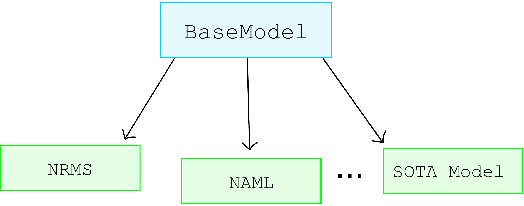

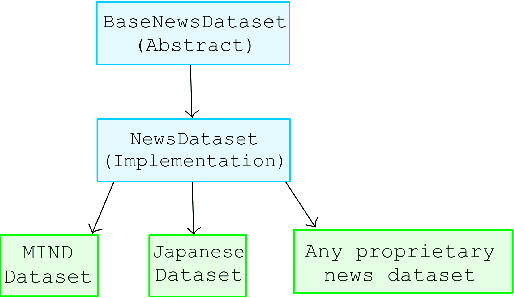

Reproducing and comparing results in news recommendation research has become increasingly difficult. This is due to a fragmented ecosystem of diverse codebases, varied configurations, and mainly due to resource-intensive models. We introduce NewsReX, an open-source library designed to streamline this process. Our key contribution is a modern implementation built on Keras 3 and JAX, which provides an increase in computational efficiency. Experiments show that NewsReX is faster than current implementations. To support broader research, we provide a straightforward guide and scripts for training models on custom datasets. We validated this functionality using a proprietary Japanese news dataset from Nikkei News, a leading Japanese media corporation renowned for its comprehensive coverage of business, economic, and financial news. NewsReX makes reproducing complex experiments faster and more accessible to a wider range of hardware making sure the speed up it also achieved for less powerful GPUs, like an 8GB RTX 3060 Ti. Beyond the library, this paper offers an analysis of key training parameters often overlooked in the literature, including the effect of different negative sampling strategies, the varying number of epochs, the impact of random batching, and more. This supplementary analysis serves as a valuable reference for future research, aiming to reduce redundant computation when comparing baselines and guide best practices. Code available at https://github.com/igor17400/NewsReX.
What Data is Really Necessary? A Feasibility Study of Inference Data Minimization for Recommender Systems
Aug 29, 2025Data minimization is a legal principle requiring personal data processing to be limited to what is necessary for a specified purpose. Operationalizing this principle for recommender systems, which rely on extensive personal data, remains a significant challenge. This paper conducts a feasibility study on minimizing implicit feedback inference data for such systems. We propose a novel problem formulation, analyze various minimization techniques, and investigate key factors influencing their effectiveness. We demonstrate that substantial inference data reduction is technically feasible without significant performance loss. However, its practicality is critically determined by two factors: the technical setting (e.g., performance targets, choice of model) and user characteristics (e.g., history size, preference complexity). Thus, while we establish its technical feasibility, we conclude that data minimization remains practically challenging and its dependence on the technical and user context makes a universal standard for data `necessity' difficult to implement.
Refining Text Generation for Realistic Conversational Recommendation via Direct Preference Optimization
Aug 28, 2025Conversational Recommender Systems (CRSs) aim to elicit user preferences via natural dialogue to provide suitable item recommendations. However, current CRSs often deviate from realistic human interactions by rapidly recommending items in brief sessions. This work addresses this gap by leveraging Large Language Models (LLMs) to generate dialogue summaries from dialogue history and item recommendation information from item description. This approach enables the extraction of both explicit user statements and implicit preferences inferred from the dialogue context. We introduce a method using Direct Preference Optimization (DPO) to ensure dialogue summary and item recommendation information are rich in information crucial for effective recommendations. Experiments on two public datasets validate our method's effectiveness in fostering more natural and realistic conversational recommendation processes.Our implementation is publicly available at: https://github.com/UEC-InabaLab/Refining-LLM-Text
A Self-Supervised Mixture-of-Experts Framework for Multi-behavior Recommendation
Aug 28, 2025In e-commerce, where users face a vast array of possible item choices, recommender systems are vital for helping them discover suitable items they might otherwise overlook. While many recommender systems primarily rely on a user's purchase history, recent multi-behavior recommender systems incorporate various auxiliary user behaviors, such as item clicks and cart additions, to enhance recommendations. Despite their overall performance gains, their effectiveness varies considerably between visited items (i.e., those a user has interacted with through auxiliary behaviors) and unvisited items (i.e., those with which the user has had no such interactions). Specifically, our analysis reveals that (1) existing multi-behavior recommender systems exhibit a significant gap in recommendation quality between the two item types (visited and unvisited items) and (2) achieving strong performance on both types with a single model architecture remains challenging. To tackle these issues, we propose a novel multi-behavior recommender system, MEMBER. It employs a mixture-of-experts framework, with experts designed to recommend the two item types, respectively. Each expert is trained using a self-supervised method specialized for its design goal. In our comprehensive experiments, we show the effectiveness of MEMBER across both item types, achieving up to 65.46% performance gain over the best competitor in terms of Hit Ratio@20.
The Hidden Cost of Defaults in Recommender System Evaluation
Aug 28, 2025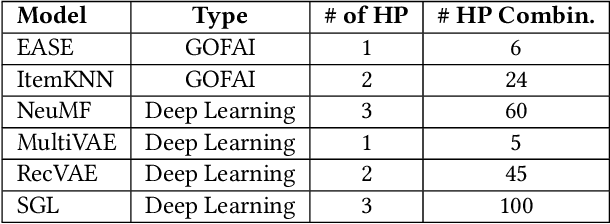
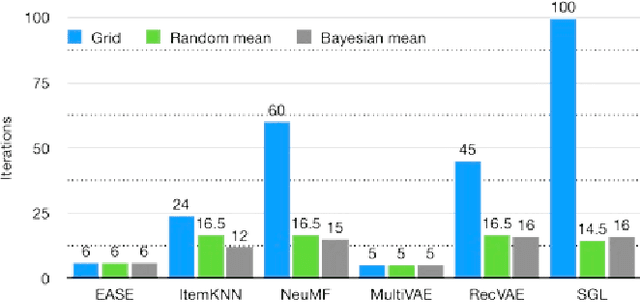
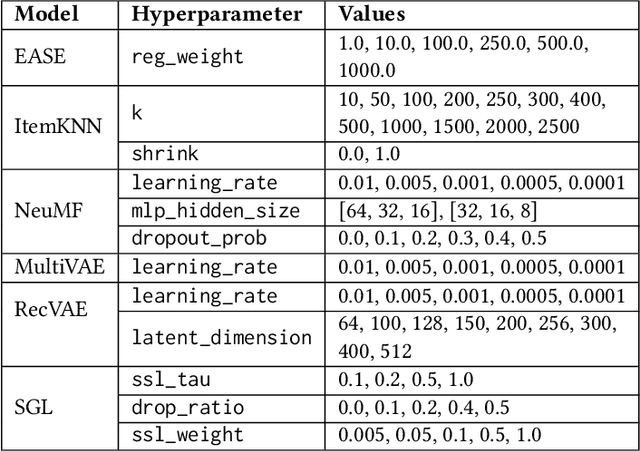

Hyperparameter optimization is critical for improving the performance of recommender systems, yet its implementation is often treated as a neutral or secondary concern. In this work, we shift focus from model benchmarking to auditing the behavior of RecBole, a widely used recommendation framework. We show that RecBole's internal defaults, particularly an undocumented early-stopping policy, can prematurely terminate Random Search and Bayesian Optimization. This limits search coverage in ways that are not visible to users. Using six models and two datasets, we compare search strategies and quantify both performance variance and search path instability. Our findings reveal that hidden framework logic can introduce variability comparable to the differences between search strategies. These results highlight the importance of treating frameworks as active components of experimental design and call for more transparent, reproducibility-aware tooling in recommender systems research. We provide actionable recommendations for researchers and developers to mitigate hidden configuration behaviors and improve the transparency of hyperparameter tuning workflows.
Designing Smarter Conversational Agents for Kids: Lessons from Cognitive Work and Means-Ends Analyses
Aug 28, 2025This paper presents two studies on how Brazilian children (ages 9--11) use conversational agents (CAs) for schoolwork, discovery, and entertainment, and how structured scaffolds can enhance these interactions. In Study 1, a seven-week online investigation with 23 participants (children, parents, teachers) employed interviews, observations, and Cognitive Work Analysis to map children's information-processing flows, the role of more knowledgeable others, functional uses, contextual goals, and interaction patterns to inform conversation-tree design. We identified three CA functions: School, Discovery, Entertainment, and derived ``recipe'' scaffolds mirroring parent-child support. In Study 2, we prompted GPT-4o-mini on 1,200 simulated child-CA exchanges, comparing conversation-tree recipes based on structured-prompting to an unstructured baseline. Quantitative evaluation of readability, question count/depth/diversity, and coherence revealed gains for the recipe approach. Building on these findings, we offer design recommendations: scaffolded conversation-trees, child-dedicated profiles for personalized context, and caregiver-curated content. Our contributions include the first CWA application with Brazilian children, an empirical framework of child-CA information flows, and an LLM-scaffolding ``recipe'' (i.e., structured-prompting) for effective, scaffolded learning.
OneRec-V2 Technical Report
Aug 28, 2025Recent breakthroughs in generative AI have transformed recommender systems through end-to-end generation. OneRec reformulates recommendation as an autoregressive generation task, achieving high Model FLOPs Utilization. While OneRec-V1 has shown significant empirical success in real-world deployment, two critical challenges hinder its scalability and performance: (1) inefficient computational allocation where 97.66% of resources are consumed by sequence encoding rather than generation, and (2) limitations in reinforcement learning relying solely on reward models. To address these challenges, we propose OneRec-V2, featuring: (1) Lazy Decoder-Only Architecture: Eliminates encoder bottlenecks, reducing total computation by 94% and training resources by 90%, enabling successful scaling to 8B parameters. (2) Preference Alignment with Real-World User Interactions: Incorporates Duration-Aware Reward Shaping and Adaptive Ratio Clipping to better align with user preferences using real-world feedback. Extensive A/B tests on Kuaishou demonstrate OneRec-V2's effectiveness, improving App Stay Time by 0.467%/0.741% while balancing multi-objective recommendations. This work advances generative recommendation scalability and alignment with real-world feedback, representing a step forward in the development of end-to-end recommender systems.
 Add to Chrome
Add to Chrome Add to Firefox
Add to Firefox Add to Edge
Add to Edge